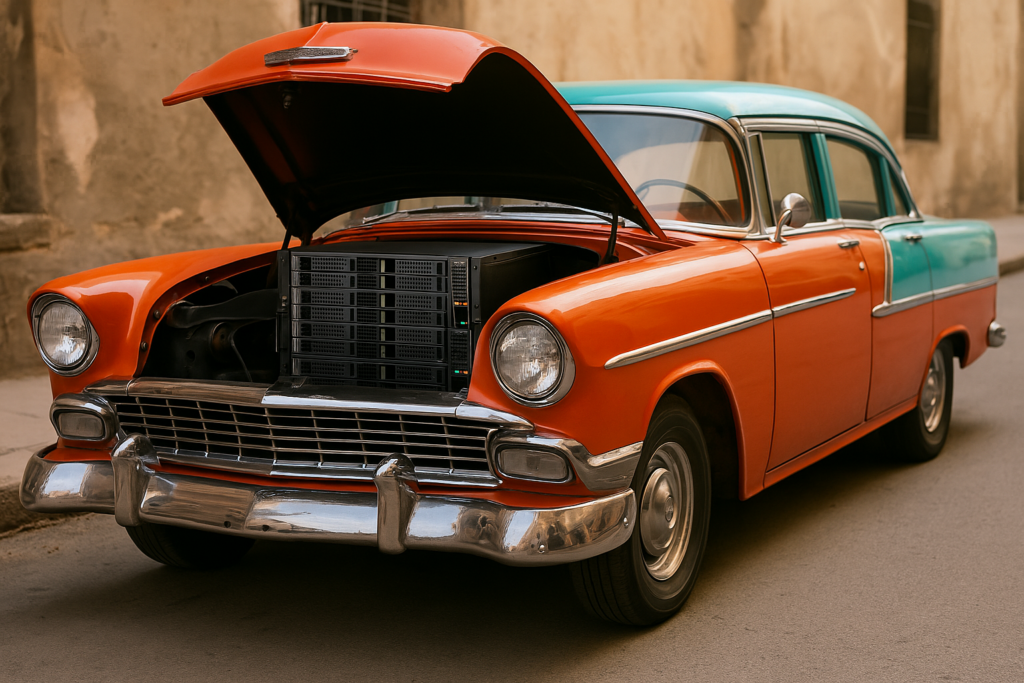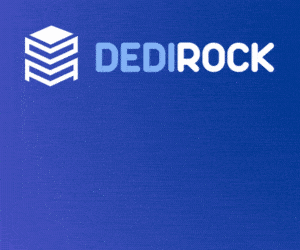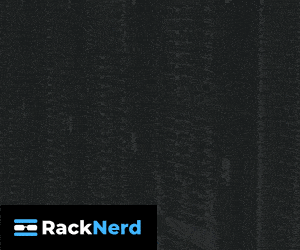 In the streets of Havana, American cars from the 1950s still chug along, lovingly maintained for decades despite their age: Ford Fairlanes and Falcons, Pontiacs and Studebakers, Bel Airs and Stylelines, as well as FIATs and Alfa Romeos, Mercedes-Benz SLs and Volkswagen Karmann-Ghias, and Soviet-era Ladas and Volgas.
In the streets of Havana, American cars from the 1950s still chug along, lovingly maintained for decades despite their age: Ford Fairlanes and Falcons, Pontiacs and Studebakers, Bel Airs and Stylelines, as well as FIATs and Alfa Romeos, Mercedes-Benz SLs and Volkswagen Karmann-Ghias, and Soviet-era Ladas and Volgas.
It’s not that Cubans have an island-wide classic car fetish. These “Yank tanks” are the product of ingenuity in the face of scarcity. Cuba, under decades of U.S. sanctions, couldn’t import new cars or parts, so it preserved what it had.
A similar phenomenon may be emerging in the world of web hosting, where rising tariffs and global supply chain disruptions are pushing providers toward holding onto aging server hardware far longer than usual. The “Cubanization” of servers may be a looming reality.
Over the past several years, geopolitical tensions have increasingly influenced the availability and pricing of IT hardware. Tariffs on Chinese-manufactured components—motherboards, processors, networking gear—have driven up prices significantly. In response, many hosting providers are delaying server upgrades, scavenging parts, and optimizing legacy systems instead of cycling out hardware on the usual 3-to-5-year schedule. This retrenchment mirrors the Cuban strategy: make do with what you have, because replacement is too expensive or too risky.
The impact is especially pronounced in the budget and mid-tier segments of the market, where tight margins make new hardware procurement a tough sell. We often see servers with 10- or even 15-year-old CPUs – e.g., the L5520, a 4c/8t 2.5Ghz released in early 2009. Just the other day, we posted a $39/month offer for an e3-1260v6, which was first released in 2017.
The Coming Tariffs
When a new rack server suddenly costs 20% more due to import duties or shipping costs, many providers will stick with existing gear. Systems on DDR3/DDR4 should be in the twilight of their careers but instead are still being offered.
There’s also a growing ecosystem around this aging hardware. Hosting forums and sysadmin communities are full of tips on BIOS modding, undervolting CPUs, and squeezing more IOPS out of decade-old SATA SSDs. Like Cuban mechanics who keep ‘57 Chevys running with homemade gaskets and Soviet-era spark plugs, sysadmins are learning to coax performance out of machines that were considered obsolete years ago, and ever-improving hypervisors and kernels helps.
Yet, the Cubanization of servers carries risks. Older hardware is inherently less power-efficient, for one. Long-expired warranties are another. In Cuba, broken cars sometimes sit idle for months while a rare part is machined by hand. While clever sysadmins can work miracles, they’re not going to make their own RAM, so the impacts are more immediate: lost customers.
Then again, for $39/month, a lot of hobbyists will roll the dice.
The environmental consequences are not as straightforward as “old system uses more juice”. Extending the life of hardware reduces e-waste and delays the carbon-intensive process of manufacturing new servers.
There’s also a broader economic implication. Hosting infrastructure underpins everything from small business websites to global SaaS platforms. If the foundational layer of that infrastructure becomes brittle and outdated due to geopolitical pricing pressures, the entire stack above it could suffer. Performance, scalability, and security all depend on reliable, modern hardware. A Cubanized server market might be inventive, but it won’t be competitive long-term.

The situation is already prompting some providers to explore alternative sourcing strategies: refurbishing gear locally, importing from tariff-exempt countries, or even considering RISC-V or ARM-based platforms to circumvent x86-centric supply issues. Others are doubling down on virtualization efficiency—running more with less—to stretch their existing hardware further. Still, these are stopgap solutions. Unless trade policies shift or new supply routes open, the industry may be stuck in a prolonged hardware holding pattern.
The comparison to Cuba isn’t perfect—no one’s welding Soviet alternators into HP servers just yet—but the spirit is similar. In a world of constrained access and rising costs, the hosting industry may need to embrace a kind of technological resilience and thrift that hasn’t been seen in decades. Whether this becomes a blip or a new normal depends on both policy and innovation. One thing is clear: the era of cheap, easily replaced servers may be ending, and a Cuban-style culture of maintenance and longevity might be taking its place.























The “Cubanization” of servers is a fascinating trend. Tariffs are forcing providers to keep older hardware running. It’s like maintaining classic cars, a challenge, but necessary. Will this impact gaming? Imagine playing the Sprunki game on vintage servers! Performance could suffer, but ingenuity might prevail. Extending hardware life reduces e-waste, a plus. Long-term, innovation is key to remain competitive despite these trade pressures.
That’s amazing! Seeing those vintage cars in Havana must be like stepping back in time. I’m reminded of a local car show I went to recently. There were some beautifully restored classics, but nothing quite as exotic as what you describe. You know, if you’re into quirky car experiences, maybe check out something like Eggy Car online sometime – it’s nothing like a classic, but it’s definitely… memorable!